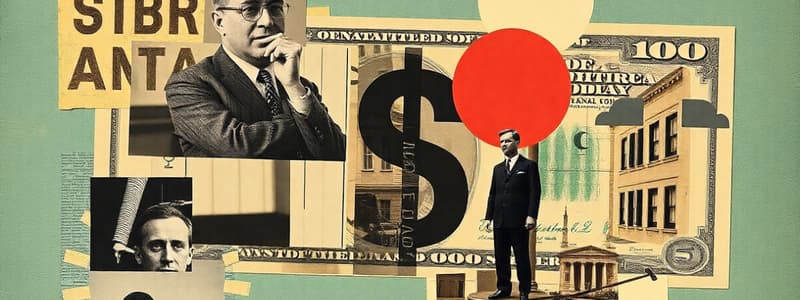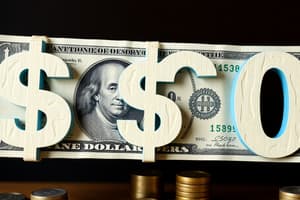Podcast
Questions and Answers
What is inflation primarily characterized by?
What is inflation primarily characterized by?
- A high level of currency in circulation
- A rise in interest rates across the board
- An increase in average prices (correct)
- A decrease in the supply of goods
How does the quantity of money influence the economy according to the quantity theory of money?
How does the quantity of money influence the economy according to the quantity theory of money?
- It directly affects the savings rate of individuals
- It determines the level of employment in industries
- It influences price levels and inflation rates (correct)
- It impacts foreign exchange rates and trade balances
What is the primary determinant of the demand for real money balances according to the quantity theory?
What is the primary determinant of the demand for real money balances according to the quantity theory?
- The nominal interest rate
- The rate of inflation
- The opportunity cost of holding assets
- Income levels (correct)
Which of the following concepts is analogous to how seismologists study earthquakes to analyze economic principles?
Which of the following concepts is analogous to how seismologists study earthquakes to analyze economic principles?
How does the nominal interest rate affect the demand for real money balances?
How does the nominal interest rate affect the demand for real money balances?
What term describes the revenue governments can generate from printing money?
What term describes the revenue governments can generate from printing money?
Which early economist is known for contributing to the foundations of the quantity theory of money?
Which early economist is known for contributing to the foundations of the quantity theory of money?
What does the Fisher equation relate to in the context of holding money?
What does the Fisher equation relate to in the context of holding money?
What effect does inflation typically have on nominal interest rates?
What effect does inflation typically have on nominal interest rates?
According to the content, what is the expected real return on money when inflation is considered?
According to the content, what is the expected real return on money when inflation is considered?
What does the letter L represent in the general money demand function (M/P)d=L(i,Y)?
What does the letter L represent in the general money demand function (M/P)d=L(i,Y)?
What is one major concern regarding inflation as discussed in the chapter?
What is one major concern regarding inflation as discussed in the chapter?
What is the role of the central bank in the context of money supply?
What is the role of the central bank in the context of money supply?
What does the cost of holding money equal in economic terms?
What does the cost of holding money equal in economic terms?
Which statement accurately describes the relationship between nominal interest rates and actual inflation?
Which statement accurately describes the relationship between nominal interest rates and actual inflation?
What happens to the demand for real money balances when income levels rise?
What happens to the demand for real money balances when income levels rise?
What behavior did patrons exhibit in pubs during the German hyperinflation?
What behavior did patrons exhibit in pubs during the German hyperinflation?
How does hyperinflation differ from moderate inflation in terms of tax revenue?
How does hyperinflation differ from moderate inflation in terms of tax revenue?
What role does money lose as hyperinflation escalates?
What role does money lose as hyperinflation escalates?
What do governments often do to combat hyperinflation's effects on currency?
What do governments often do to combat hyperinflation's effects on currency?
What typically replaces the official currency during hyperinflation?
What typically replaces the official currency during hyperinflation?
What is the primary cause of hyperinflation?
What is the primary cause of hyperinflation?
What impact does hyperinflation have on consumer behavior?
What impact does hyperinflation have on consumer behavior?
Why do customers find carrying money burdensome during hyperinflation?
Why do customers find carrying money burdensome during hyperinflation?
What does the expression 'not worth a continental' signify?
What does the expression 'not worth a continental' signify?
What was established by the Mint Act of 1792?
What was established by the Mint Act of 1792?
If the nominal interest rate is 8% and the inflation rate is 5%, what is the real interest rate?
If the nominal interest rate is 8% and the inflation rate is 5%, what is the real interest rate?
According to the Fisher equation, what does the nominal interest rate depend on?
According to the Fisher equation, what does the nominal interest rate depend on?
Which of the following statements is true regarding nominal and real interest rates?
Which of the following statements is true regarding nominal and real interest rates?
If prices have risen significantly, what can be inferred about the relationship between nominal interest rates and purchasing power?
If prices have risen significantly, what can be inferred about the relationship between nominal interest rates and purchasing power?
What can happen to the nominal interest rate based on changes in the economy?
What can happen to the nominal interest rate based on changes in the economy?
If the nominal interest rate is equated to the sum of the real interest rate and inflation, which scenario will result in a decrease in the nominal rate?
If the nominal interest rate is equated to the sum of the real interest rate and inflation, which scenario will result in a decrease in the nominal rate?
What is the effect of a higher nominal interest rate on the demand for real money balances?
What is the effect of a higher nominal interest rate on the demand for real money balances?
How does the price level depend on the money supply according to the formal models?
How does the price level depend on the money supply according to the formal models?
What is the primary reason nominal contracts are common despite the risks associated with uncertain inflation?
What is the primary reason nominal contracts are common despite the risks associated with uncertain inflation?
In which situation is indexation in contracts more likely to occur?
In which situation is indexation in contracts more likely to occur?
What misconception does the average person have regarding inflation and their wages?
What misconception does the average person have regarding inflation and their wages?
What was a significant political consequence of the deflation in the United States from 1880 to 1896?
What was a significant political consequence of the deflation in the United States from 1880 to 1896?
According to classical theory of money, what does a change in the price level represent?
According to classical theory of money, what does a change in the price level represent?
What might happen to workers' raises if the central bank reduces inflation?
What might happen to workers' raises if the central bank reduces inflation?
What adjustment is made to Social Security benefits in the United States in relation to inflation?
What adjustment is made to Social Security benefits in the United States in relation to inflation?
What principle is illustrated by the relationship between high inflation and variability in inflation rates?
What principle is illustrated by the relationship between high inflation and variability in inflation rates?
Which of the following statements aligns with the classical response to inflation?
Which of the following statements aligns with the classical response to inflation?
What monetary reform was proposed by the Free Silver Movement of the late nineteenth century?
What monetary reform was proposed by the Free Silver Movement of the late nineteenth century?
What is a potential outcome when dollar figures in the economy are multiplied by ten?
What is a potential outcome when dollar figures in the economy are multiplied by ten?
What explains the complexity of money's effect on prices beyond the quantity theory?
What explains the complexity of money's effect on prices beyond the quantity theory?
Why did inflation-indexed bonds become necessary in the U.S. financial system?
Why did inflation-indexed bonds become necessary in the U.S. financial system?
Which economic group benefited from the deflation experienced in the U.S. from 1880 to 1896?
Which economic group benefited from the deflation experienced in the U.S. from 1880 to 1896?
Flashcards
Inflation
Inflation
An increase in the average prices of goods and services in an economy.
Price
Price
The rate at which money is exchanged for a good or service.
Money Supply
Money Supply
The total amount of money available in an economy, including cash, checking accounts, and other liquid assets.
Monetary Policy
Monetary Policy
Signup and view all the flashcards
Quantity Theory of Money
Quantity Theory of Money
Signup and view all the flashcards
Inflation Rate
Inflation Rate
Signup and view all the flashcards
Inflation Tax
Inflation Tax
Signup and view all the flashcards
Nominal Interest Rate
Nominal Interest Rate
Signup and view all the flashcards
Commodity Money
Commodity Money
Signup and view all the flashcards
Interest Rate
Interest Rate
Signup and view all the flashcards
Real Interest Rate
Real Interest Rate
Signup and view all the flashcards
Fisher Equation
Fisher Equation
Signup and view all the flashcards
Fisher Effect
Fisher Effect
Signup and view all the flashcards
Fiat Money
Fiat Money
Signup and view all the flashcards
Bimetallic Standard
Bimetallic Standard
Signup and view all the flashcards
Gold Standard
Gold Standard
Signup and view all the flashcards
Uncertain Inflation
Uncertain Inflation
Signup and view all the flashcards
Indexed Contract
Indexed Contract
Signup and view all the flashcards
Risk Aversion
Risk Aversion
Signup and view all the flashcards
Indexation
Indexation
Signup and view all the flashcards
Free Silver Movement
Free Silver Movement
Signup and view all the flashcards
How does a higher nominal interest rate affect the demand for money?
How does a higher nominal interest rate affect the demand for money?
Signup and view all the flashcards
What happens to the price level when money demand falls with a constant money supply?
What happens to the price level when money demand falls with a constant money supply?
Signup and view all the flashcards
How do expectations of future money growth affect the current price level?
How do expectations of future money growth affect the current price level?
Signup and view all the flashcards
What factors determine the price level?
What factors determine the price level?
Signup and view all the flashcards
What drives inflation?
What drives inflation?
Signup and view all the flashcards
What is a common misconception about inflation's effects?
What is a common misconception about inflation's effects?
Signup and view all the flashcards
How does the classical theory explain the effects of inflation?
How does the classical theory explain the effects of inflation?
Signup and view all the flashcards
What happens to real wages when inflation slows down?
What happens to real wages when inflation slows down?
Signup and view all the flashcards
Relative prices and hyperinflation
Relative prices and hyperinflation
Signup and view all the flashcards
Hyperinflation and consumer behavior
Hyperinflation and consumer behavior
Signup and view all the flashcards
Hyperinflation and tax revenue
Hyperinflation and tax revenue
Signup and view all the flashcards
The inconvenience of hyperinflation
The inconvenience of hyperinflation
Signup and view all the flashcards
Cause of hyperinflation
Cause of hyperinflation
Signup and view all the flashcards
Money printing and hyperinflation
Money printing and hyperinflation
Signup and view all the flashcards
Ending hyperinflation
Ending hyperinflation
Signup and view all the flashcards
Alternative currencies during hyperinflation
Alternative currencies during hyperinflation
Signup and view all the flashcards
What is the opportunity cost of holding money?
What is the opportunity cost of holding money?
Signup and view all the flashcards
Quantity Theory of Money: Money Demand
Quantity Theory of Money: Money Demand
Signup and view all the flashcards
Factors affecting the demand for real money balances
Factors affecting the demand for real money balances
Signup and view all the flashcards
Real return on holding money
Real return on holding money
Signup and view all the flashcards
Comparing real returns on money and other assets
Comparing real returns on money and other assets
Signup and view all the flashcards
Cost of holding money = nominal interest rate
Cost of holding money = nominal interest rate
Signup and view all the flashcards
Money demand function
Money demand function
Signup and view all the flashcards
Interrelationship between money, prices, and interest rates
Interrelationship between money, prices, and interest rates
Signup and view all the flashcards
Study Notes
Inflation: Its Causes, Effects, and Social Costs
- Lenin believed the best way to destroy capitalism was to debauch the currency.
- Inflation is the overall increase in the price level.
- In 1970, a New York Times cost 15 cents, the median price of a single-family home was $23,400, and average wages for production workers were $3.39 per hour. In 2017, prices had increased to:
- $2.50 for a Times
- $317,200 median home price
- $20.90 average wage
- Inflation rates vary across countries and time periods.
Quantity Theory of Money
- Money is exchanged for goods/services at a specific rate (price).
- The quantity of money relates to prices & income.
- The theory is based on the work of David Hume.
- The quantity equation, M x V = P x T:
- M = Money supply
- V = Velocity of money
- P = Price level
- T = Total transactions.
- The velocity measures how many times a dollar bill changes hands in a specific period.
- The quantity equation shows that changes in one variable necessitate a change in another variable.
- To maintain equality, if the money supply increases and velocity remains stable, then either the price level or the number of transactions increase.
Money Demand Function and Quantity Equation
- Money demand is the need for transactions to buy goods and services.
- The quantity of money is related to the number of dollars traded in transactions.
- The real money balances (M/P) are the purchasing power of the money stock (M).
- A simple money demand function is (M/P)d=kY.
- M/P is the real money balances
- k is the amount of money demanded for each dollar of income.
- The demand for real money balances is proportional to real income.
Inflation and Interest Rates
- Nominal interest rate: The interest rate charged by banks or paid on investments.
- Real interest rate: The difference between the nominal interest rate and the inflation rate.
- The Fisher equation shows the relationship between these variables: r = i - π
- r = real interest rate
- i = nominal interest rate
- π = inflation rate.
Seigniorage
- Revenue is raised through printing money, known as seigniorage.
- Often used in emergencies or when raising funds is difficult.
- Inflation is a type of tax collected from holding money.
Hyperinflation
- Hyperinflation is extreme inflation, usually > 50% per month.
- Characterized by a rapid increase in prices and the money supply.
- Costs of extreme inflation include shoeleather costs (frequent transactions for higher prices), menu costs (frequent changes in prices), and difficulties with tax systems.
Social costs of Inflation
- Inflation is typically a social problem that concerns a decrease in purchasing power.
- Unexpected inflation has a redistributive effect which hurts some people while benefiting others.
- Expected inflation is less harmful than unexpected.
Studying That Suits You
Use AI to generate personalized quizzes and flashcards to suit your learning preferences.




